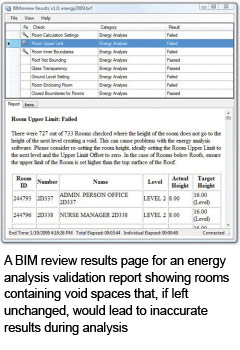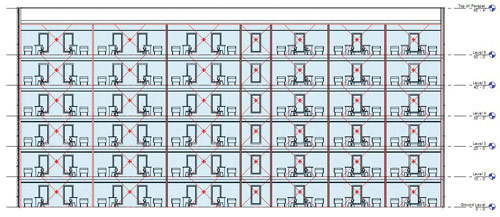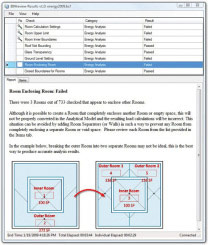Improving Public Funds Use through BIM Accuracy: Altering the Role of the BIM Manager
The severity of the current economic downturn has seen the public sector striving to increase the value of its services. While private construction projects languish due to the credit crunch, new government building projects are emerging to create jobs and keep the economy moving. In the midst of this opportunity, government decision makers are under even more pressure than usual to ensure optimal use of tax dollars.
 Project managers can look to building information modeling (BIM) for help. Over the last few years, BIM -based projects have enabled collaboration, improved construction accuracy and reduced rework in the field. The model itself offers significant benefits to a building team of designers, engineers, project managers and construction managers. However, it takes just one human input error to render a model incorrect and inconsistent, and multiple contributors compound inconsistencies. BIM is a valuable process, but its models need validation checks to ensure consistent standards, accurate content, and the use of modeling techniques that support integration with other disciplines.
BIM Complexity Leads to New Role
Building information models have become more complex as more people from different disciplines contribute to the model, or create their own smaller models for particular aspects of a project. To manage this complexity, a new role has emerged. Today, large projects require a BIM manager to ensure the integrity of the information in the model. This person typically spends long hours painstakingly testing the BIM for integrity against a variety of aspects and situations. For example, are all disciplines using appropriate naming standards?
And architects at Avatech, a company of experts in design automation and technology services, whose customers work with large government projects, saw that the time spent in this process of finding and correcting inconsistencies in the BIM could be significantly reduced by automating it.
Organizations have been investing a significant amount of time reviewing, fixing and auditing their building models to ensure they adhere to industry and project standards. Automating this manual process should improve efficiency, ensure model integrity and enable designers to spend more time on design.
Efficiently Improving BIM Quality
Project managers can look to building information modeling (BIM) for help. Over the last few years, BIM -based projects have enabled collaboration, improved construction accuracy and reduced rework in the field. The model itself offers significant benefits to a building team of designers, engineers, project managers and construction managers. However, it takes just one human input error to render a model incorrect and inconsistent, and multiple contributors compound inconsistencies. BIM is a valuable process, but its models need validation checks to ensure consistent standards, accurate content, and the use of modeling techniques that support integration with other disciplines.
BIM Complexity Leads to New Role
Building information models have become more complex as more people from different disciplines contribute to the model, or create their own smaller models for particular aspects of a project. To manage this complexity, a new role has emerged. Today, large projects require a BIM manager to ensure the integrity of the information in the model. This person typically spends long hours painstakingly testing the BIM for integrity against a variety of aspects and situations. For example, are all disciplines using appropriate naming standards?
And architects at Avatech, a company of experts in design automation and technology services, whose customers work with large government projects, saw that the time spent in this process of finding and correcting inconsistencies in the BIM could be significantly reduced by automating it.
Organizations have been investing a significant amount of time reviewing, fixing and auditing their building models to ensure they adhere to industry and project standards. Automating this manual process should improve efficiency, ensure model integrity and enable designers to spend more time on design.
Efficiently Improving BIM Quality
 Avatech’s software development group responded with a product called BIM review, released in December 2008. The software helps CAD managers, BIM coordinators, project managers and facility managers save time and money while increasing confidence in BIM completeness and accuracy.
The application works directly inside the Revit platform to check, correct and manage the information in a building model. By reviewing geometry and data against a given set of criteria, the software ensures that the project model adheres to company standards, industry best practices and criteria set for a specific project.
Altering the Role of BIM Manager
By automating the checking and correcting of BIM inaccuracies, the BIM manager role is transformed from that of a digital drawing sheet reviewer to an information and team manager. Instead of spending time checking and correcting, BIM managers can now spend their day communicating with project partners to develop and enforce standards. They can also spend more time identifying areas for training and developing programs to improve consistency across internal departments and with external project partner organizations.
Avatech’s software development group responded with a product called BIM review, released in December 2008. The software helps CAD managers, BIM coordinators, project managers and facility managers save time and money while increasing confidence in BIM completeness and accuracy.
The application works directly inside the Revit platform to check, correct and manage the information in a building model. By reviewing geometry and data against a given set of criteria, the software ensures that the project model adheres to company standards, industry best practices and criteria set for a specific project.
Altering the Role of BIM Manager
By automating the checking and correcting of BIM inaccuracies, the BIM manager role is transformed from that of a digital drawing sheet reviewer to an information and team manager. Instead of spending time checking and correcting, BIM managers can now spend their day communicating with project partners to develop and enforce standards. They can also spend more time identifying areas for training and developing programs to improve consistency across internal departments and with external project partner organizations.
 A BIM review Report Page Showing a Multi-Story Hospital Section Showing Rooms That Require Changes
During these tough economic times, when government projects are forming a larger portion of the job market, doing things smarter will help stretch public funds. Automatic BIM validation and correction is one means by which the design industry can help ensure tax dollars are used wisely and that projects meet budget, design and social objectives.
A BIM review Report Page Showing a Multi-Story Hospital Section Showing Rooms That Require Changes
During these tough economic times, when government projects are forming a larger portion of the job market, doing things smarter will help stretch public funds. Automatic BIM validation and correction is one means by which the design industry can help ensure tax dollars are used wisely and that projects meet budget, design and social objectives.
 A BIM review Results Page for Energy Analysis
Validation Report Showing Room Enclosing Issues
By Beau Turner, Director Business Development, Building Solutions Group, Avatech Solutions
Originially published in [acronym] magazine, Issue 10
A BIM review Results Page for Energy Analysis
Validation Report Showing Room Enclosing Issues
By Beau Turner, Director Business Development, Building Solutions Group, Avatech Solutions
Originially published in [acronym] magazine, Issue 10
 Project managers can look to building information modeling (BIM) for help. Over the last few years, BIM -based projects have enabled collaboration, improved construction accuracy and reduced rework in the field. The model itself offers significant benefits to a building team of designers, engineers, project managers and construction managers. However, it takes just one human input error to render a model incorrect and inconsistent, and multiple contributors compound inconsistencies. BIM is a valuable process, but its models need validation checks to ensure consistent standards, accurate content, and the use of modeling techniques that support integration with other disciplines.
BIM Complexity Leads to New Role
Building information models have become more complex as more people from different disciplines contribute to the model, or create their own smaller models for particular aspects of a project. To manage this complexity, a new role has emerged. Today, large projects require a BIM manager to ensure the integrity of the information in the model. This person typically spends long hours painstakingly testing the BIM for integrity against a variety of aspects and situations. For example, are all disciplines using appropriate naming standards?
And architects at Avatech, a company of experts in design automation and technology services, whose customers work with large government projects, saw that the time spent in this process of finding and correcting inconsistencies in the BIM could be significantly reduced by automating it.
Organizations have been investing a significant amount of time reviewing, fixing and auditing their building models to ensure they adhere to industry and project standards. Automating this manual process should improve efficiency, ensure model integrity and enable designers to spend more time on design.
Efficiently Improving BIM Quality
Project managers can look to building information modeling (BIM) for help. Over the last few years, BIM -based projects have enabled collaboration, improved construction accuracy and reduced rework in the field. The model itself offers significant benefits to a building team of designers, engineers, project managers and construction managers. However, it takes just one human input error to render a model incorrect and inconsistent, and multiple contributors compound inconsistencies. BIM is a valuable process, but its models need validation checks to ensure consistent standards, accurate content, and the use of modeling techniques that support integration with other disciplines.
BIM Complexity Leads to New Role
Building information models have become more complex as more people from different disciplines contribute to the model, or create their own smaller models for particular aspects of a project. To manage this complexity, a new role has emerged. Today, large projects require a BIM manager to ensure the integrity of the information in the model. This person typically spends long hours painstakingly testing the BIM for integrity against a variety of aspects and situations. For example, are all disciplines using appropriate naming standards?
And architects at Avatech, a company of experts in design automation and technology services, whose customers work with large government projects, saw that the time spent in this process of finding and correcting inconsistencies in the BIM could be significantly reduced by automating it.
Organizations have been investing a significant amount of time reviewing, fixing and auditing their building models to ensure they adhere to industry and project standards. Automating this manual process should improve efficiency, ensure model integrity and enable designers to spend more time on design.
Efficiently Improving BIM Quality
 Avatech’s software development group responded with a product called BIM review, released in December 2008. The software helps CAD managers, BIM coordinators, project managers and facility managers save time and money while increasing confidence in BIM completeness and accuracy.
The application works directly inside the Revit platform to check, correct and manage the information in a building model. By reviewing geometry and data against a given set of criteria, the software ensures that the project model adheres to company standards, industry best practices and criteria set for a specific project.
Altering the Role of BIM Manager
By automating the checking and correcting of BIM inaccuracies, the BIM manager role is transformed from that of a digital drawing sheet reviewer to an information and team manager. Instead of spending time checking and correcting, BIM managers can now spend their day communicating with project partners to develop and enforce standards. They can also spend more time identifying areas for training and developing programs to improve consistency across internal departments and with external project partner organizations.
Avatech’s software development group responded with a product called BIM review, released in December 2008. The software helps CAD managers, BIM coordinators, project managers and facility managers save time and money while increasing confidence in BIM completeness and accuracy.
The application works directly inside the Revit platform to check, correct and manage the information in a building model. By reviewing geometry and data against a given set of criteria, the software ensures that the project model adheres to company standards, industry best practices and criteria set for a specific project.
Altering the Role of BIM Manager
By automating the checking and correcting of BIM inaccuracies, the BIM manager role is transformed from that of a digital drawing sheet reviewer to an information and team manager. Instead of spending time checking and correcting, BIM managers can now spend their day communicating with project partners to develop and enforce standards. They can also spend more time identifying areas for training and developing programs to improve consistency across internal departments and with external project partner organizations.
 A BIM review Report Page Showing a Multi-Story Hospital Section Showing Rooms That Require Changes
During these tough economic times, when government projects are forming a larger portion of the job market, doing things smarter will help stretch public funds. Automatic BIM validation and correction is one means by which the design industry can help ensure tax dollars are used wisely and that projects meet budget, design and social objectives.
A BIM review Report Page Showing a Multi-Story Hospital Section Showing Rooms That Require Changes
During these tough economic times, when government projects are forming a larger portion of the job market, doing things smarter will help stretch public funds. Automatic BIM validation and correction is one means by which the design industry can help ensure tax dollars are used wisely and that projects meet budget, design and social objectives.
 A BIM review Results Page for Energy Analysis
Validation Report Showing Room Enclosing Issues
By Beau Turner, Director Business Development, Building Solutions Group, Avatech Solutions
Originially published in [acronym] magazine, Issue 10
A BIM review Results Page for Energy Analysis
Validation Report Showing Room Enclosing Issues
By Beau Turner, Director Business Development, Building Solutions Group, Avatech Solutions
Originially published in [acronym] magazine, Issue 10















































